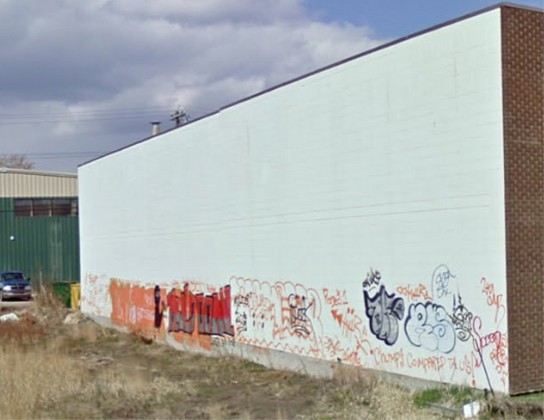Graffiti fight a font of problems for Edmonton businessman
 These days, Otto Weltzien wishes he’d never called the police about the graffiti outside his business. If he’d thought about that at the beginning, he might still have his interesting wall, he’d have his art … and he’d still have $16,500.
These days, Otto Weltzien wishes he’d never called the police about the graffiti outside his business. If he’d thought about that at the beginning, he might still have his interesting wall, he’d have his art … and he’d still have $16,500.
Weltzien, 78, spent part of 2010 fighting an order by the city issued the year against his company, O & M Investments, to clean up the the west wall of his building at 10024 79 Ave. The building contains his family’s business, Minerva Mini Storage, and is just northeast of the Canadian Pacific Railway yard in Old Strathcona. (It’s also right behind Edmonton Bicycle Commuters.)
Weltzien says he didn’t like the graffiti much at first and even called the police about it. But then he says some of it grew on him. Some of it was pretty plain. But there a couple of works in giant, multi-coloured letters that Weltzien thought were impressive. He said they were beyond his abilities.
It wasn’t exactly a Banksy. It wasn’t even as good as many of the examples of creative graffiti that exist here in Edmonton. But Weltzien says he wanted it to stay. “Some of it was attractive. It certainly wasn’t offensive,” Weltzien says, speaking by phone from B.C. where he spends about 10 days of every month. “A lot of people remarked they remembered my business because of it. I’d be giving them directions, and they’d say, ‘Oh, that’s where the wall with the paint is.'”
Edmonton’s Community Standards Bylaw states property owners can’t permit buildings to show “signs of serious disregard for maintenance and upkeep,” and includes examples such as “any graffiti displayed on the building that is visible from any surrounding property.”
Weltzien appealed the order to remove the graffiti to the city’s Community and License Appeal Committee but lost. As was his right under the Municipal Government Act, which states rulings can be challenged if the Act isn’t followed or the committee’s decision was “patently unreasonable,” he brought the matter before the Alberta Court of Queen’s Bench.
He hired a lawyer and went to court on Feb. 23, 2010. Weltzien’s first argument for keeping the graffiti was a technical one, claiming the city’s bylaw officers had written the order to remove it for the wrong address.
His building stretched across several addresses, he claimed, and the address where the graffiti was located was different from the one that was on the order.
His second and third arguments to the court were much more interesting. He claimed that the city appeals committee had failed to address his arguments that the material on the wall was art and not graffiti. Further, he argued that forcing him to remove the graffiti was an unreasonable limit on his freedom of expression and was therefore a violation of the Charter of Rights and Freedoms.
In the ruling that was issued three days later on Feb. 26, Justice Brian Burrows dismissed Weltzien’s appeal. Burrows rejected the argument about the mistaken address outright, noting that while the address on the city’s order could have been more precise, there was never any confusion about were the graffiti was located.
There were problems with the other arguments as well. On the distinction between graffiti and art, Burrows noted Weltzien failed to raise the issue in the context of whether the order was invalid for not being within the city’s graffiti bylaw. While the judge acknowledged the transcript of the city appeal committee hearing contained a number of instances where the issue was discussed, it wasn’t enough.
Burrows cited Weltzien’s opening statement to the committee where he told the members City Hall informed him that “graffiti and art would be decided by the City of Edmonton.” But that wasn’t the same as arguing the order was wrong for requiring him to remove something that wasn’t graffiti.
“Mr. Weltzien never submitted that the Order under appeal should be rescinded because the painting on the wall of O & M’s building was art and not graffiti. It was reasonable for the Committee not to deal with a point that was never raised,” Burrows said in his ruling.
Placing too much emphasis on the wrong-address issue also cost Weltzien later on the art argument. Burrows noted that Weltzien claimed in his closing remarks to the city appeals committee that the art vs. graffiti issue wasn’t even part of the proceeding, and that the real issue for him was the wrong address.
“Mr. Weltzien expressly states that the possible distinction between art and graffiti was not in issue in the proceedings before the Committee,” Burrows wrote.
Finally, Burrows wrote he was unconvinced the order to remove the graffiti was a Charter infringement on Weltzien’s right to free expression, noting the painting on the wall was never Weltzien’s expression in the first place.
Calling the police about the graffiti didn’t help, according to Burrows. The judge noted that at one point, Weltzien told the city he was unable to clean the wall because the owner of the vacant lot next door refused him access to the property.
“(The record) indicates that O & M’s efforts to remove the display from the wall had been frustrated by the refusal of the owner of the neighbouring vacant lot to permit it access for that purpose,” Burrows wrote.
“An intention to remove the display, even a frustrated intention, is inconsistent with the adoption of the display as one’s expression.”
Burrows noted Weltzien had failed to raise the Charter infringement issueat all during his appeal to the committee. Therefore, he wrote, it wasn’t proper to raise the issue during the appeal of the committee’s order to the court.
The ruling stung for Weltzien. Defending the graffiti had cost him $16,500 and he says it would have cost him more if his lawyer hadn’t been a family friend who he says wrote off a lot of the cost. He says he really felt bad for his lawyer, who was heartbroken. He sent her flowers the next day.
Weltzien says his wife was mad he’d spent so much money. He says it was too expensive to keep on fighting, so now the graffiti is covered in brown paint. Failing to cover it, or keep it covered from future painters, could cost him $10,000 or up to a year in jail, he says.
“Sometimes there’s a painting and you don’t really like it at first, but then later it grows on you,” Weltzien says, claiming it happened that way for him with the graffiti. “What is art? Is a Chagall art? What about Picasso?”
Weltzien says he’s gained a new appreciation for graffiti, and having grown up in Germany, has recently taken an interest in the messages and art that covered the Berlin Wall. He says he regrets having called the police about the graffiti in the beginning. He says it was simply a case of being slow to appreciate what the graffiti artists had done.
He wishes the court could have recognized his change of heart. “Even though I didn’t give permission at first, I gave it later that it could stay,” he says.













